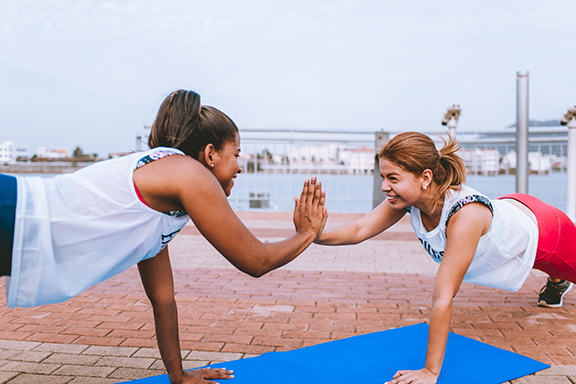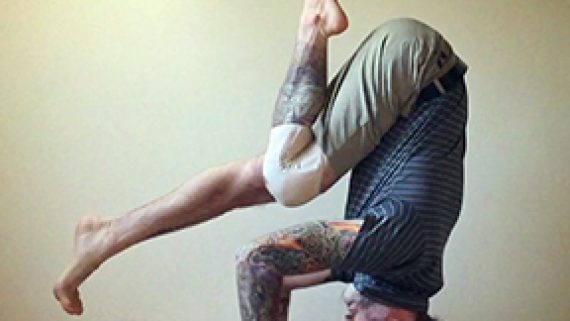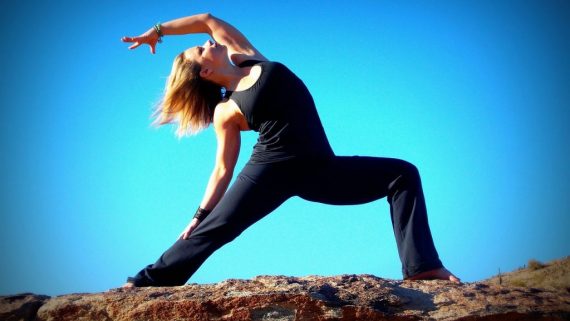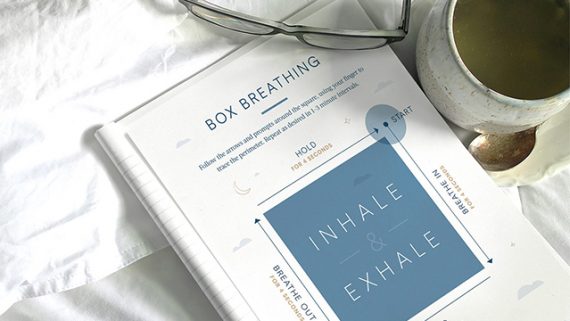Secrets of a Yogi: Losing & Keeping 40 Pounds Off
How I Lost 40 Pounds and Kept It Off
By: Amanda Woodard
I’m no one in the fitness community. I do not have a personal training certification, a nutritionist license or an Instagram page with 10,000+ followers. I just started yoga teacher training, but I still can’t do crow pose, even though I’ve been working on it for over a year. I rock climb, but I’m terrified of heights, so my progress has been even slower there. But here’s why I’m writing this: I lost 40 pounds in two years, and I’ve kept the weight off for over a year now. This is my fitness journey.

Amanda “Before & After” shedding 40 pounds.
The Formula for Losing Weight
Most of us know the formula for losing weight: burn more calories than you’re taking in.
The trouble is that instead of searching for long-lasting solutions, people search for things like:
- How to lose weight fast
- How to lose weight and keep it off
- How to get a bikini body
- How to get ready for hot girl summer
It’s important to know that any “get-thin-quick” scheme is going to be short-lived, leaving you even hungrier than you were before. My journey is not quick. Per my intro paragraph, you can see I’m one for slow progress, and I believe because the progress was slow and intentional I was able to make fitness a lifestyle change.
Before I go through the steps I took to lose weight, let’s be real and honest with ourselves:
How Did I Gain So Much Weight?
There are a few culprits to weight gain and obesity. Some people come to this destination from different routes. I’ll start off by admitting that I was never obese in my childhood. I fluctuated from being a “healthy” weight and being a little overweight (no more than 10 pounds) for most of my life.
Here are a few reasons I gained weight:
- I didn’t keep track of my nutritional or caloric intake. I ate whatever I wanted. Pizza every night? Sure, why not? I’m a grown-up, and no one’s gonna tell me “No.”
- I lived a sedentary lifestyle. Man, did I love watching movies and TV. And sitting to read books. And sitting to play board games. And just sitting.
- I watched shows that increased my appetite. (Note: These shows did not make me more hungry. They just made me want to eat.) Hello, Gilmore Girls and Master Chef.
- I enjoyed illegal activities that increased my appetite. (Cough, cough.)
- I drank my calories. Obviously, I ate them too, but what I’m saying here is that I would have several sodas a day. Multiple. And coffee. And wine. And sugary-sweet alcoholic beverages.
- I started “snacking” on foods that were intended to be full meals. Toaster Strudels? Sure, why not four?
- I stopped working out. I’ve historically had an inconsistent relationship with exercise. Typically, the only thing that motivated me to sweat on purpose was looking in the mirror and being disgusted with myself.
- I stopped looking in the mirror. As I started to gain weight, I stopped looking at myself and avoided looking at pictures of myself. I stopped taking and posting selfies. I stopped weighing myself. I stopped tracking my progress altogether.
- I got really depressed. When I was riddled with negative self-talk, hopelessness and possessive feelings of worthlessness, I turned to food. I stayed in bed. I avoided doing my work, and that made me feel worse, which drove me to eat, and drink more alcohol, and stay in bed more.
Can Anyone Relate?
If you’re struggling to maintain a “healthy” weight, then it’s likely that you can relate to most of these situations.
But either way, that’s a lot, right? That’s really too much to be focused on at once. And on top of those major lifestyle changes I needed to make to lose weight, I also wanted to be better about taking care of my skin, getting my work done, doing my school work, cleaning my apartment, being a better partner to my girlfriend at the time, and many, many other things.
In the past, I would consider all the things I wanted to change about myself and just feel like, “Wow, that’s really too much. It’s hopeless.” Or: I would think, “I can change all of these things right now. In just two weeks, I’ll be a completely different person.” Neither of those mindsets are helpful. You have to be able to take it one step at a time.
Which leads us to the actual steps for losing weight in my case. Remember, your fitness journey is YOURS. This one is mine:
Step 1: Boost Self-Confidence
It’s no wonder people always want to lose weight FAST. People associate being thin with being attractive, but that’s not necessarily true. Actually, being thin doesn’t necessarily even mean you’re healthy. But the point is that people feel like they can’t be attractive unless they have a six pack or at least a flat stomach, which is wild.
Tons of people can be soft, overweight or obese and still be attractive, still find romance, still find love.
So, what I’m saying here is: You don’t have to be thin to be attractive or to feel confident. The confidence can come first, before you even lose a single pound. And that confidence can help you push through the hard parts of your exercise routine and your new eating habits.
Here are a few things I did to boost my own confidence before I lost even a little bit of weight:
- I got really into makeup. Listen, I know: The beauty industry is tricking women in spending thousands of dollars a year to buy into the idea that we’re not naturally beautiful. That’s true. But it’s also true that eyeliner makes me feel freaking pretty, OK?
- I made eye contact with myself in the mirror. Avoiding my reflection was part of how things got so out of hand for me. I made it a point to look at and affirm myself.
- I said my own name. I mostly did this in my self-talk; I didn’t refer to myself in the third person in conversation, but it really helped me focus, which was really helpful when I wanted to introduce a new affirmation.
- I bought clothes that fit me. For a while, I tried hiding my body in my clothes or cramming myself into clothes that were too tight, and neither made me feel good. Once I got clothes that flattered my figure, I was able to feel attractive and confident, even when I had to go up a size or two.
- I let myself take up space. When I was self-conscious about being big, I’d hunch over in an attempt to make myself smaller. Then I learned about this technique called Wonder Woman-ing. Standing like you’re confident can make you more confident, in the same way smiling, even when you’re not happy, can make you happy. I stood up straight and opened myself up and felt better.
- I celebrated small victories. I played mobile phone games that I knew I could win, and when I did, I was like, “Wow, Amanda, you are so smart.” Seriously, that helped a ton.
- I danced in my underwear in front of a mirror. Making eye contact with myself was romantic and all, but I needed to appreciate my body the way it was. It was hard for me to look at myself, so I dressed up in my laciest lingerie, put on some upbeat music, and danced badly with my reflection. It was fun and silly and made me feel really hot.
- I tried new things. I was getting my undergrad during this time, and I signed up for extracurricular activities that seemed challenging and fun. I let myself explore things that interested me. I let myself do whatever I wanted, as long as it wasn’t hurting anyone else.
Step 2: Move Just a Little More
Here are some small changes I made to make myself move a little more:
- I took the stairs whenever I could.
- I walked across campus.
- I took long walks (alone and with my roommate’s dog).
- I experimented with a standing desk at my internship.
- I parked far away from store entrances.
- I helped people move.
- I volunteered for things that required minor physical labor.
- I did more activities that required walking, like window shopping and attending museums.
- I enjoyed urban exploration (which I didn’t know other people did at the time, so I referred to it as “industrial hiking”).
- I rode my bike to campus a few times. (I’m not very good at riding a bike, and I almost died, so I stopped doing that, but hey, I tried it, you know?)
Step 3: Pay Attention to Your Caloric Intake
I started by paying attention to what I ate: the goal being to do so without judgement. I kept a food journal and wrote down everything I ate. I recorded the calories. From there, I got an honest look at how many calories I ate each day on average. Here’s the interesting part though: Just tracking my eating habits changed the way I ate. When I realized, “Damn, I really had pizza every night this week for dinner,” I wasn’t as likely to have it again for dinner that night.
At first, I was surprised to find I ate well over 2,000 daily calories, but if you think about it, most of the meals we eat at restaurants have insane portion sizes and caloric values. I started by getting my daily calorie intake down to 2,000 (although 2,000 is actually an overestimation for most people).
At my current activity level, my daily intake should be around 1,800, which doesn’t sound like a lot but totally does feel satisfying. If you’re paying attention to your caloric intake and you find you’re eating more calories than you’d like to, cutting back doesn’t have to be a struggle.
You can easily lower your calorie count by:
- Drinking zero-calorie or low-calorie beverages. Water and naturally flavored sparkling water are better than diet sodas, but do what you need to do to help you transition out of bad habits (more on this later). Kombucha is also a delicious low-calorie soda alternative.
- Trading up your snacks. Instead of snacking on chips, try dipping carrot sticks in hummus. Something I like to do to quell my sweet-n-savory needs is dip apple slices in guacamole. Yeah, it sounds gross, but have you tried it?
- Indulging in decadent desserts. Instead of eating a typical dessert, one that you’ve enjoyed in excess in the past, try a heavier dessert that gets you to slow down. If you love chocolate, try dark chocolate instead. The bitterness will help you stop and savor the sweetness. You’ll be surprised how little you need to eat to satisfy your sweet tooth.
Step 4: Start a Realistic Fitness Routine
Every year, you vow to lose weight. You make it your New Year’s Resolution, and when January rolls around, you push yourself harder than you ever have before, thinking: Maybe if I work really, really hard this month, I’ll make it to my weight goal by February.
How did that work out for you? If you’ve kept this up for several weeks now, or even for the whole month, you’ve probably seen some encouraging results, but man, are you wiped! What if you just took a rest day? And another one, and another one…. And before you know it, you’ve gained the weight back.
This was the story of my whole freaking life until late 2017. When I finally accepted that I needed to slow down, I started my new workout routine by getting a gym membership to a place that had a sauna. Three times a week, I would go to the gym and just sit in it for 20 minutes with a book, and then I would go home. For real. That’s where I was at, fitness-wise. But you know what? It got me into the habit of going to the gym. And eventually, I was like, “Well, if I’m going to get all sweaty anyway, I might as well start walking on the treadmill.” And then it was like, “Well, a few crunches wouldn’t kill me.” Until I was spending an hour and a half at the gym because I WANTED to.
But again, that wasn’t a workout routine I was able to maintain. I learned what my limits were, and I adjusted.
Step 5: Track Your Progress — But Be Gentle with Yourself
If you’re changing your lifestyle, not just trying to lose weight, then the progress is going to be slow, and that has to be OK. Like that old man says when he’s fixing Woody up in Toy Story 2, “You can’t rush art.
Fitness experts will tell you not to weigh yourself every day. Instead, weigh yourself once a week and make sure it’s first thing in the morning — after you’ve peed, before you’ve had anything to eat or drink. That’s your baseline weight. (Don’t be surprised if you weigh yourself just a few hours later — which you really shouldn’t do — to find that you’ve gained 2 to 3 pounds.)
Despite what the experts say, I do weigh myself every day, and here’s why: I have a very hard time assessing my body without doing it. I’ll eat a big dinner and think, “God, I must have gained at least two whole pounds.” I’ll get on the scale the next morning, thinking, If I gained weight, it’s no big deal; I can just lose it again.
One of the mantras I created through this process is: A body is not a finite state of being. I’m allowed to change.
But then, plot twist: I haven’t gained weight at all. I’m either right where I was the day before or I weigh even less. Feeling bloated or full often give me false perceptions, so weighing myself gives me a daily reality check and keeps me on track.
You know yourself better than anyone, so you may find that this isn’t the best move for you, and that you should stick to weighing yourself once a week or so. Either way, be gentle with yourself. While the numbers on the scale reflect your progress, they don’t reflect your value as a person. You’re worthy of love and affection, no matter what the scale says.
Step 6: Make Exercise Fun
There are tons of ways to work out that don’t involve going to the gym and grumpily hitting the treadmill. I’ve never been particularly sporty, so finding a workout that was actually fun for me took me a long, long time. I tried soccer (indoor and outdoor), and I really hated it. There’s so much running, so much trying not to get hit by the ball, so much being hit by the ball anyway. I was always coming home with giant bruises — on my shins and my ego. No thanks.
Team sports that involve running just aren’t for me. Running really isn’t for me either. That runner’s high? Heard of it; can’t relate.
I tried a cycling class, and I was like, “Huh, this isn’t so bad. What’s all the fuss about?” It must have been a beginner’s class that day because when I went the next day, I nearly blacked out on the bike. I saw spots and I was really dizzy and I felt like the petals were moving my legs, not the other way around.
I’ve always really loved yoga, but I didn’t practice very often because — well, money, first of all, but at the heart of it was that I didn’t think I was good enough to practice regularly. I didn’t want other people to see me wobbling all over the place or sweating really hard in a “resting” pose. But no matter how bad I was at yoga, I still loved it. So, I just let myself be bad at it and kept doing it, and gradually, I saw progress. I let myself love it enough to sign up for yoga teacher training, even though my balance is (currently) garbage.
You know what else I’m bad at that I really love? Rock climbing. I’m terrified of heights. It took me so, so long just to be able to climb to the top of a top-rope wall (a short one), but I kept going and I kept trying, and eventually I did it. I go with a group of friends who are really encouraging and who let me baby myself when I need to.
Step 7: Embrace a Lifestyle, Not a Diet
This is the part where I tell you I’m vegan. But please don’t go! I’m sure you’re tired of being shamed for loving the taste of bacon, but the truth is: We ALL love the taste of bacon. No one is immune to cravings for that savory, sizzly goodness.
Just because I chose to become vegan doesn’t mean you have to be. You can consider other ways of altering your eating that can make you feel more energized, clear-headed and satisfied. You can cut processed sugar, vow to never drink a soda again, cut out premade foods with ingredients you can’t pronounce — whatever. It’s your journey!
My journey to becoming vegan, much like every single other area of my life, took ages. I tried raw veganism in 2013, and I lost a bunch of weight, and I felt awesome, but I also just really, really wanted to eat something hot and cheesy. I gained all the weight back and then some. For me (at that moment in time), that just wasn’t sustainable.
I became a vegetarian in 2017 for ethical reasons and said to anyone who would listen, “I’ll never be vegan. I love cheese too much. Eggs are too cost-effective.” And then a documentary that had absolutely nothing to do with veganism made me realize that I could be doing more to slow down climate change, so I became vegan on April 1, 2019.
Have I cheated? Hell yeah. When I travel, it’s almost impossible to find vegan alternatives, so I’ll eat vegetarian. And on Thanksgiving, my friend made some mac ‘n’ cheese that I just could not resist. I’m not perfect. But I found a diet (a new lifestyle, really) that helps me be more conscientious about what I’m putting in my body.
The more mindful you are about what you’re eating, the less likely you are to gain the weight back. But it’s important to be gentle with yourself here too. Set aside time to cheat if you must, but don’t quit!
Step 8: Cut Out Bad Habits
Now, this is the part where I tell you I’m sober — and the part where I tell you that I’m not pushing this onto you. I have my own reasons for quitting drinking, etc. But I will say that drinking alcohol does make it really hard to lose weight. It’s tough not to do it: It’s not only a socially acceptable way to let loose, but it can feel awkward if you don’t drink at certain social gatherings.
And besides these excuses, I just really, really liked drinking. And satisfying the drunchies. And smoking and satisfying the munchies. And watching dramatic, dopamine-releasing shows that made me want to eat more.
I was able to quit the shows before smoking and drinking. I finally quit smoking because it exacerbated my anxiety. But it took me ages to quit drinking, even though it made me feel awful the next day, every time I did it. I never would have been able to quit drinking if it weren’t for the support of my friends. If I had people telling me things like, “One drink won’t kill you,” then I wouldn’t have even had the strength to become “sober curious.”
I’m not saying you should quit drinking, but quitting the bad habits that are linked to your weight gain are crucial to weight loss.
New Year, New Me: Right Now
After taking all these steps, I live a completely different life. Because I’ve changed my eating habits (through veganism and sobriety), I no longer have to count my calories. I’m surrounded by friends who are also trying to be more active, so I’m encouraged to stay in shape, even if what I really want to do is binge-watch the latest Netflix original. Because I’ve found exercises I enjoy, it doesn’t feel like a chore to stay active and healthy. Now that I’m able to look back on all my progress, the self-confidence I found at the beginning of my fitness journey has been affirmed.
I used to beat myself for starting workout routines and then quitting them, starting diets and then quitting those too. My negative self-talk told me that I was a quitter. But do you know what’s equally true about quitting fitness routines? You start them again. You can’t quit something if you never started it. I let myself be someone who starts things, who tries new things, who forgives myself when I fall short of my own expectations. I changed my expectations for myself. I saw myself for who I really was, not who I hoped to be, and I let that be OK.

Amanda Woodward
Author Bio:
Amanda Woodard is an MFA candidate at Antioch University and a freelance copywriter at mediamanda.com. Her work has been performed in Oral Fixation and published in Ten Spurs, Keep This Bag Away from Children and FlashFlood. When she’s not working or studying, she enjoys playing board games, rock climbing and listening to audiobooks.









